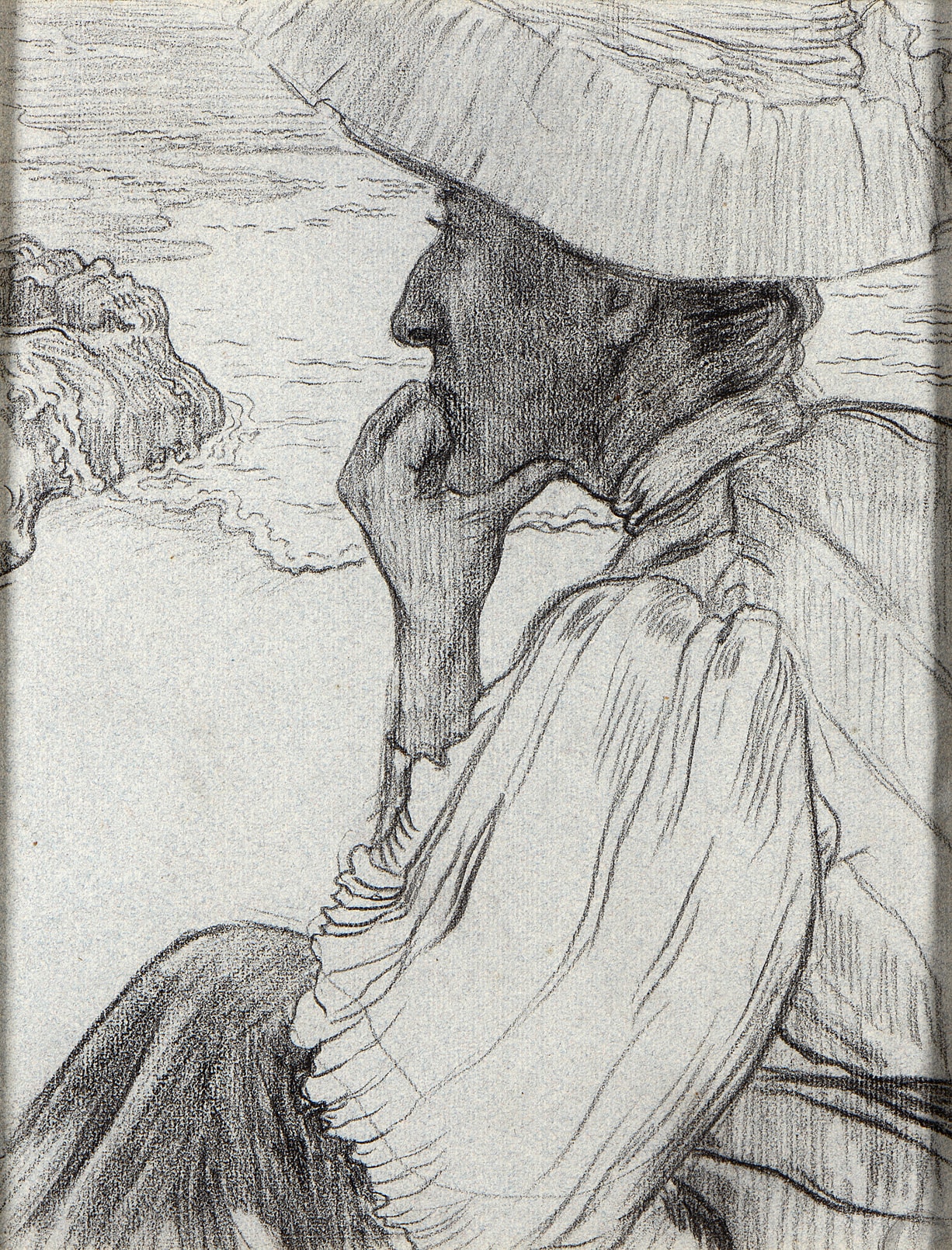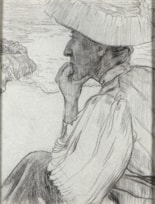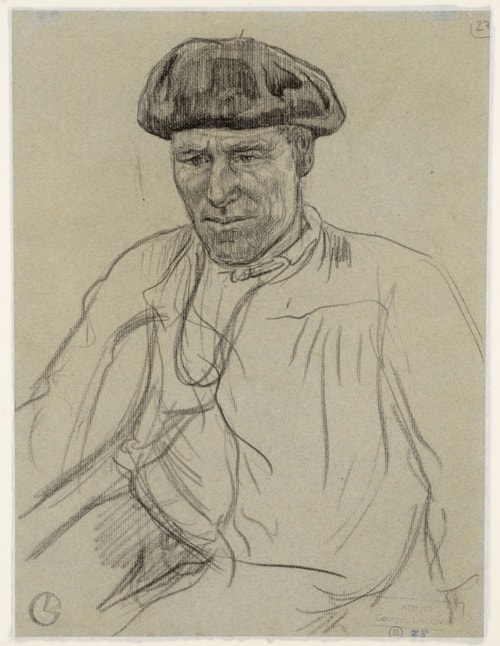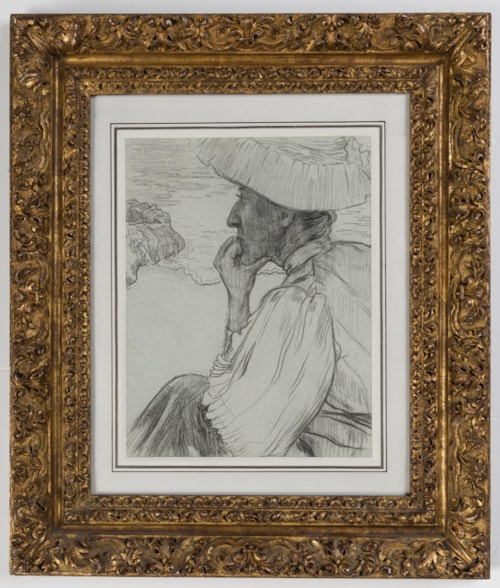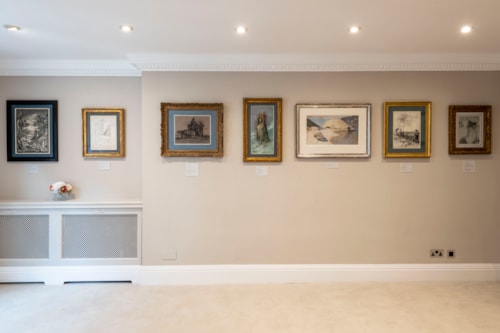Georges LACOMBE
(Versailles 1868 - Alençon 1916)
Portrait of Mme. Gabrielle Wenger at Camaret-sur-Mer [recto]; Portrait of the Seaman Piriou [verso]
Black chalk on blue-grey paper; a page from a sketchbook.
Stamped with the Lacombe studio stamp (Lugt 4390) at the lower right, and with the studio stamp (Lugt 4390) and Lacombe family estate inheritance stamp (Lugt 4391) on the verso.
Further stamped with the 1974 Shepherd Gallery Lacombe exhibition stamp SG in a circle (ref. Lugt 4390), with associated catalogue number 28 written in ink, on the verso.
315 x 236 mm. (12 3/8 x 9 1/4 in.)
Stamped with the Lacombe studio stamp (Lugt 4390) at the lower right, and with the studio stamp (Lugt 4390) and Lacombe family estate inheritance stamp (Lugt 4391) on the verso.
Further stamped with the 1974 Shepherd Gallery Lacombe exhibition stamp SG in a circle (ref. Lugt 4390), with associated catalogue number 28 written in ink, on the verso.
315 x 236 mm. (12 3/8 x 9 1/4 in.)
This drawing depicts Gabrielle Wenger, née Questroy (1854-1944), the mother of the artist’s future wife Marthe, seated on the cliffs above Camaret-sur-Mer, on the Crozon peninsula overlooking the sea. When Lacombe made this drawing in 1895, Gabrielle was a widow; her first husband Adolphe Wenger had died two years earlier. Gabrielle Wenger shared with Lacombe an interest in music; she hosted musical soirées and concerts at her home in Versailles, which the artist regularly attended, and was herself a talented pianist. She was also one of Lacombe’s patrons, commissioning from him a series of decorative wall paintings for her house in Versailles in 1893. Lacombe made several drawings of Gabrielle Wenger; one such example, drawn in coloured chalks and probably executed a year earlier than the present sheet, is in a private collection. A large, full-length pastel portrait of Mme. Wenger seated at a piano, dated 1896, is in the collection of the Musée Lambinet in Versailles.
The drawing on the verso of the present sheet is a portrait of a Breton sailor named Piriou, who helped Lacombe sail the Greska, the boat which the artist kept at Camaret. Lacombe produced a number of drawings of Piriou, whose wife and daughter were also the subject of drawings that were originally in the same Breton sketchbook as the present sheet. This sketchbook was made up of sheets of blue paper, with most of the drawings datable to 1895 and depicting Breton subjects. Several drawings were removed from this sketchbook in the 1970s, of which the present sheet is one, and the remainder of the now-unbound Breton sketchbook entered the collection of the Louvre in 1983.
The drawing on the verso of the present sheet is a portrait of a Breton sailor named Piriou, who helped Lacombe sail the Greska, the boat which the artist kept at Camaret. Lacombe produced a number of drawings of Piriou, whose wife and daughter were also the subject of drawings that were originally in the same Breton sketchbook as the present sheet. This sketchbook was made up of sheets of blue paper, with most of the drawings datable to 1895 and depicting Breton subjects. Several drawings were removed from this sketchbook in the 1970s, of which the present sheet is one, and the remainder of the now-unbound Breton sketchbook entered the collection of the Louvre in 1983.
Active as a painter and sculptor, Georges Lacombe received his first lessons in drawing from his mother Laure, who was a painter and printmaker of some talent. He completed his training as a pupil of Alfred Roll and Henri Gervex at the Académie Julian in Paris, where he met Emile Bernard. Between 1889 and 1897 Lacombe spent his summers at Camaret-sur-Mer, in the Finistère département on the west coast of Brittany, where he encountered a number of artists, including Maxime Maufra, Charles Cottet and Henri Rivière. In 1892 he met Paul Sérusier and soon afterward joined the Nabis; a group of young artists united by a passionate interest in the work of Paul Gauguin and a desire to develop a new, more expressive pictorial language, in which form and colour were as important in their own right as subject matter. The Nabis artists included Sérusier, Pierre Bonnard, Edouard Vuillard, Ker-Xavier Roussel, Maurice Denis and Félix Vallotton, among others. Lacombe painted Breton figure scenes and somewhat artificial, stylized seascapes, in which the influence of Japanese landscape prints is evident. Around 1893 Lacombe met Gauguin, and was inspired by his carved wooden sculptures to begin sculpting in wood himself, creating Symbolist works characterized by a naive technique, and soon becoming widely known as ‘Le nabi sculpteur’.
Of independent means, Lacombe did not need to make a living from his art, and seems to have chosen not to sell his work. Nevertheless, he exhibited regularly at the Salon des Indépendants and the Salon d’Automne, as well as with the Nabis group at the galleries Le Barc de Boutteville and Durand-Ruel, as well as with Ambroise Vollard. He also commissioned mural decorations from both Sérusier and Paul Ranson. Shortly after his marriage in 1897, Lacombe settled in a house called l’Ermitage, in the Écouves forest near Alençon in Normandy. His isolation from the artistic milieu in Paris, as well as his wooded surroundings, had an effect on his style, with his landscapes becoming more naturalistic. In the early years of the 20th century, Lacombe met and came under the influence of Théo van Rysselberghe, and began painting landscapes in a pointillist manner, later moving to a more Impressionistic style. He carried on working as a sculptor in wood, producing several busts of fellow artists which were shown at the Salon d’Automne of 1911.
Lacombe’s reticence in selling his work during his lifetime has meant that, for many years after his death in 1916, at the age of just forty-eight, his oeuvre remained relatively obscure. Apart from a retrospective exhibition of his paintings, drawings and sculptures at a Parisian gallery in 1924, his work was not widely shown in public until a major Nabis exhibition in Paris in 1955. Works by Lacombe are in the collections of the Musée d’Orsay in Paris and in several provincial French museums, as well as in the Musée du Petit Palais in Geneva and the Indianapolis Museum of Art.
As a draughtsman, Georges Lacombe’s work was also little known until recently, since most of his drawings were retained by the artist, mounted into thirty-two albums and kept in his studio. These albums remained with the artist’s descendants until 1974, when some of them were broken up and the drawings dispersed.
Provenance
Once part of a sketchbook of mainly Breton subjects by Lacombe, with some sheets removed after 1965
Shepherd Gallery, Associates, New York, in 1974
Acquired from them by Mr. and Mrs. Arthur G. Altschul, New York
Galerie Hopkins-Custot, Paris
Acquired in 2003 by the Triton Collection Foundation, The Netherlands.
Literature
Joseph Downing, Georges Lacombe 1868-1916: Drawings, exhibition catalogue, New York, 1974, unpaginated, no.28, recto illustrated pl.XII; Joëlle Ansieau and Catherine Puget, Georges Lacombe 1868-1916, exhibition catalogue, Pont-Aven, 1998, p.68, no.49; Joëlle Ansieau, Georges Lacombe 1868-1916: catalogue raisonné, Paris, 1998, p.203, under Album VIII, recto illustrated; Sjraar van Heugten, Avant-gardes 1870 to the present: The Collection of the Triton Foundation, Brussels, 2012, recto illustrated p.115.
Exhibition
New York, Shepherd Gallery, Georges Lacombe 1868-1916: Drawings, 1974, no.28; Pont-Aven, Musée de Pont-Aven, Georges Lacombe 1868-1916, 1998, no.49; The Hague, Gemeentemuseum, Klaroenstoot voor de moderne kunst: De Nabis in de collectie van de Triton Foundation, 2008.

